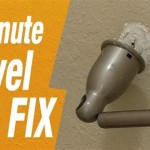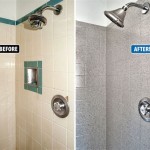How To Fix a Bathroom Sink Drain Lever
The bathroom sink drain lever, also known as a pop-up drain, is a common plumbing fixture that allows for easy opening and closing of the drain. Over time, these mechanisms can malfunction, leading to issues such as a stuck drain, a loose lever, or a drain that doesn't seal properly. Understanding the components of the drain lever system and how to troubleshoot common problems can save time, effort, and the expense of calling a plumber. This article provides a detailed guide on how to diagnose and repair a malfunctioning bathroom sink drain lever.
Before beginning any repair work, it is crucial to gather the necessary tools and supplies. A standard set of tools typically includes: pliers (both slip-joint and needle-nose), an adjustable wrench, a screwdriver (both Phillips head and flathead), penetrating oil (such as WD-40), a small bucket or container, clean rags or towels, and possibly plumber's putty.
Identifying the Components of the Bathroom Sink Drain Lever System
To effectively troubleshoot and repair a drain lever, it is essential to understand the function of each component. The system comprises the following key parts:
The Pop-Up Stopper: This is the visible component that sits in the drain opening inside the sink. It moves up and down to either seal the drain or allow water to flow freely.
The Pivot Rod: This horizontal rod connects to the pop-up stopper via a ball joint. It extends through a hole in the drainpipe and is connected to the lift rod.
The Lift Rod: This is the vertical rod that extends up behind the faucet. It is the part that is physically lifted or lowered to operate the drain.
The Lift Rod Strap: This small metal piece connects the lift rod to the pivot rod. It has several holes that allow for adjustments to the drain lever's travel.
The Pivot Rod Nut: This nut secures the pivot rod to the drainpipe. It creates a watertight seal to prevent leaks.
The Extension Rod (optional): In some setups, especially with longer distances, an extension rod bridges the lift rod and the pivot rod strap.
Understanding these components enables a systematic approach to diagnosing the problem.
Troubleshooting Common Issues with the Bathroom Sink Drain Lever
Several common issues can arise with bathroom sink drain levers. Addressing them effectively requires a methodical approach to diagnose the root cause. Here are some of the more prevalent problems:
Drain Stopper Not Sealing Properly: If the drain stopper doesn't form a tight seal, water will slowly leak out of the sink. This is often caused by debris buildup, misadjustment, or a worn-out stopper. Start by thoroughly cleaning the stopper and the drain opening. If the problem persists, check the adjustment of the lift rod strap.
Drain Stopper Stuck in the Open or Closed Position: A stuck stopper is frequently due to hair, soap scum, or other debris accumulating around the stopper and pivot rod mechanisms. Disconnecting the pivot rod and cleaning it, along with the stopper, is usually the solution. Penetrating oil can also help loosen any stubborn debris.
Lift Rod is Loose or Detached: A loose lift rod is often caused by a loose setscrew on the lift rod strap or a damaged connection point. Tighten the setscrew or replace the lift rod strap if necessary. Ensure the lift rod is properly connected to the strap.
Water Leaking from the Pivot Rod Nut: Leaks around the pivot rod nut typically result from a loose nut or a worn-out rubber seal (washer). Tightening the nut may resolve the issue temporarily. However, if the leak persists, replacing the rubber seal is often required. Disconnecting the pivot rod and replacing the washer ensures a proper seal.
Stiff or Difficult to Operate Lever: A stiff drain lever can be caused by corrosion or debris buildup in the pivot rod mechanism. Applying penetrating oil to the moving parts and working the lever back and forth can help loosen the mechanism. Cleaning the pivot rod and the surrounding area may also be necessary.
Step-by-Step Guide to Fixing a Malfunctioning Drain Lever
This section will detail the step-by-step process for addressing common drain lever issues. Always prioritize safety by turning off the water supply to the sink before commencing any repairs.
Step 1: Accessing the Drain Mechanism: Begin by clearing the area under the sink. Place a bucket or container beneath the drainpipe to catch any water or debris that may spill. Locate the pivot rod nut at the back of the drainpipe.
Step 2: Disconnecting the Lift Rod: Locate the lift rod strap that connects the lift rod to the pivot rod. Carefully detach the lift rod from the strap. This usually involves loosening a small setscrew or unclipping the rod. Ensure the lift rod is completely disconnected from the rest of the drain mechanism.
Step 3: Disconnecting the Pivot Rod: Loosen the pivot rod nut using an adjustable wrench. Turn the nut counterclockwise until it is loose enough to remove. Be prepared for some water to drip out. Once the nut is removed, gently pull the pivot rod out of the drainpipe. The pop-up stopper should now be free to be removed from inside the sink.
Step 4: Cleaning the Components: Thoroughly clean the pop-up stopper, the pivot rod, and the inside of the drainpipe. Remove any hair, soap scum, or other debris that may be causing the problem. Use a small brush or rag to clean hard-to-reach areas. Inspect the rubber seal (washer) on the pivot rod for wear and tear. If it is damaged, replace it with a new one.
Step 5: Reassembling the Drain Mechanism: Apply a small amount of plumber's grease (optional) to the pivot rod to facilitate smooth movement. Insert the pivot rod back into the drainpipe, ensuring the ball joint on the rod is properly aligned with the opening in the drainpipe where the stopper will sit. Reattach the pivot rod nut and tighten it securely, but avoid over-tightening, which can damage the seal. Lower the pop-up stopper into the drain opening inside the sink.
Step 6: Reconnecting the Lift Rod: Reconnect the lift rod to the pivot rod strap. Adjust the position of the lift rod in the strap to achieve the desired travel for the pop-up stopper. Experiment with different hole positions on the strap until the stopper seals properly when lowered and opens fully when raised. Tighten the setscrew or clip to secure the lift rod in place.
Step 7: Testing the Drain: Turn on the water supply to the sink and test the drain lever. Fill the sink with water and lower the drain stopper. Ensure the stopper creates a tight seal and that water does not leak out. Raise the drain lever to open the drain and verify that the water drains freely. Check for any leaks around the pivot rod nut. If leaks are present, tighten the nut further or replace the rubber seal.
Step 8: Addressing Specific Issues: If the drain stopper still doesn't seal properly after reassembly, double-check the alignment of the pivot rod and the position of the lift rod in the strap. Minor adjustments may be necessary to achieve optimal performance. If the lift rod is still loose, ensure the setscrew is tightened securely. If the problem persists, consider replacing the entire drain assembly.
Addressing Stripped Threads: One problem not previously mentioned is the potential for damage to the threaded portion of the drain assembly due to over-tightening or corrosion. If the pivot rod nut simply spins without tightening, the threads are likely stripped. In this case, replacing the entire drain assembly is usually the most effective solution. Attempting to repair stripped threads can be difficult and may not result in a long-lasting fix.
Dealing with Corroded Parts: In older homes, the metal components of the drain assembly may be heavily corroded. This corrosion can make it difficult to loosen the pivot rod nut or to separate the different parts of the mechanism. Applying penetrating oil generously and allowing it to soak for several hours can help loosen corroded parts. If the corrosion is severe, it may be necessary to use heat (such as a heat gun) to loosen the parts, but exercise caution to avoid damaging surrounding materials.
Properly addressing these steps should resolve most common issues with bathroom sink drain levers. Regular cleaning and maintenance will help prevent future problems and extend the life of the drain mechanism.

How To Replace Or Maintain A Sink Pop Up Drain Assembly

How To Replace Or Maintain A Sink Pop Up Drain Assembly

How To Replace Or Maintain A Sink Pop Up Drain Assembly

How To Replace Or Maintain A Sink Pop Up Drain Assembly

How To Fix A Bathroom Faucet 14 Steps

How To Fix Or Maintain Your Sink S Pop Up Mechanism

How To Replace Or Maintain A Sink Pop Up Drain Assembly

When Snaking A Drain Doesn T Work Ben Franklin Plumbing

How To Install A Sink Drain With Pictures Wikihow

How To Adjust A Bathroom Sink Stopper
Related Posts







